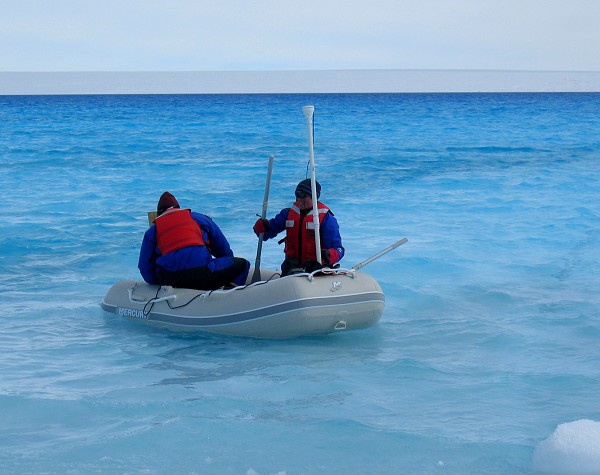 Scientists in rubber raft study ice cover for the National Snow and Ice Data Center. (NASA Photo)
Scientists in rubber raft study ice cover for the National Snow and Ice Data Center. (NASA Photo)
GREAT LAKES ICE COVER: Shrinking Arctic Ice Heightens Environmental Concern
March 16, 2019
By: Dave Rogers
Unpredictable!
That description must be applied to the ice coverage on the Great Lakes.
Because of a period of cold weather in early January, climate scientists estimate that ice cover on the lakes doubled at the end of that month.
Great Lakes Environmental Research Lab scientists are observing long-term changes in ice cover as a result of global warming.
Studying, monitoring, and predicting ice coverage on the Great Lakes plays an important role in determining climate patterns, lake water levels, water movement patterns, water temperature structure, and spring plankton blooms.
Environmental tracker Twila Moon says the Arctic now is warming on average at more than twice the rate of the world. Changes are happening very quickly in all parts of this environment: land ice is melting, permafrost is thawing, and sea ice is becoming thinner and covering less space. All three are deeply connected to each other. And they are all caused by the same fundamental behavior -- our release of greenhouse gases.
Glaciers around the world are disappearing before our eyes, and the implications for people are wide-ranging and troubling, Twila Moon, a glacier expert at the University of Colorado Boulder, concludes in a Perspectives piece in the journal Science Today.
The melting of glacial ice contributes to sea-level rise, which threatens to "displace millions of people within the lifetime of many of today's children," Moon writes. Glaciers also serve up fresh water to communities around the world, are integral to the planet's weather and climate systems, and they are "unique landscapes for contemplation or exploration."
Read more at https://phys.org/news/2017-05-goodbye-glaciers. Moon is the lead author of a commentary in Earth's Future, which tackles the expanding footprint of unprecedented Arctic change. Moon commented:
"Too often these different elements -- permafrost, sea ice, and land ice -- are talked about separately. We want to give people a real sense that changes in each of them are connected to each other and to other parts of the Arctic system. And really that these changes are influencing people very far from the Arctic.
Ice coverage across the Great Lakes more than doubled in mid-January due to a weather pattern change that has sent much colder temperatures into the central and eastern states.
On Jan. 15 the amount of ice coverage for all the Great Lakes was near 10 percent, which is below the average of 16 percent for that date. But by Jan. 22, weekly ice coverage across all five Great Lakes was at 23 percent, according to the Canadian Ice Service of Environment Canada. That's slightly above the 30-year average (1981-2010) of about 19 percent for that week.
###

